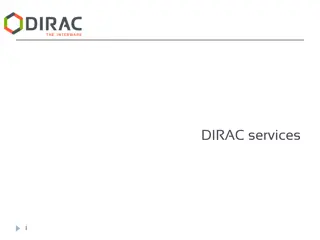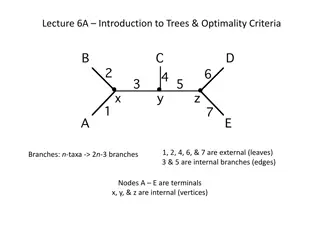
Optimal Cloud Computing Resource Allocation Strategies
Explore control issues in cloud computing, heavy traffic optimality, server capacity constraints, job scheduling, and resource allocation problems. Learn about cloud setting, workload management, and metrics of optimality for throughput and delay.
Download Presentation

Please find below an Image/Link to download the presentation.
The content on the website is provided AS IS for your information and personal use only. It may not be sold, licensed, or shared on other websites without obtaining consent from the author. If you encounter any issues during the download, it is possible that the publisher has removed the file from their server.
You are allowed to download the files provided on this website for personal or commercial use, subject to the condition that they are used lawfully. All files are the property of their respective owners.
The content on the website is provided AS IS for your information and personal use only. It may not be sold, licensed, or shared on other websites without obtaining consent from the author.
E N D
Presentation Transcript
1 CONTROL ISSUES IN CLOUD COMPUTING: HEAVY TRAFFIC OPTIMALITY R. Srikant In collaboration with Ness Shroff (OSU), Yi Lu (UIUC), Lei Ying (ASU) June 8, 2025
Work on Cloud Computing 2 Map/Reduce Framework PhD student: Zheng (OSU) Infrastructure as a Service PhD Student: Maguluri (UIUC): This talk, answers a question posed by Harry Chang at the last MURI meeting PhD Student: Qiaomin Xie, MS Student: Xiaobo Dong (UIUC) Zero-delay service
Setting 3 A cloud of identical servers with limited capacities for different resources like processing power, memory, disk space etc. Jobs (Virtual Machines) require certain amount of these resources and certain time for service Schedule jobs on the cloud meeting the resource constraints on the servers Type 2 job Type 1 job Type 3 job Server 1 Server 2 Server 3
Cloud Computing Resource Allocation problem 4 Jobs arrive according to an arrival process Multiple stages of service A router/ load balancer routes jobs to the servers Each server maintains queues for each kind of jobs Workload can be known or unknown Need a routing/ load balancing algorithm and a scheduling algorithm at each server Router 1 1 3 1 1 5 1 1 1 2 1 2 1 4 1 1 Server 1 Server 2 Server 3
Capacity of a server 5 Feasible Schedule satisfies resource constraints of jobs and servers Amazon EC2 VMs Memory CPU Storage Standard Extra Large 15GB 8 EC2 Units 1690GB High Memory Extra Large 17.1GB 6.5 EC2 Units 420 GB High-CPU Extra Large 7GB 20 EC2 Units 1690GB Server with 30GB Memory, 30EC2 Computing Units, 4000 GB Storage, (2,0,0) is feasible (0,2,1) is not feasible violates Memory constraint Capacity of a server Convex hull of feasible schedules Corner points maximal schedules
Capacity of a Cloud 6 Sum of Capacities of all the servers Corner point in the capacity region of the cloud can be written as a sum of corner points of capacity regions of all the servers Load of each type of job is the product of its arrival rate and its mean duration
Metrics of Optimality 7 Throughput Optimality Any load within the capacity region is stabilizable No bound on Delay Delay Optimality Minimize Mean Delay Minimize Mean Queue Lengths Little s Law Analytically intractable Heavy Traffic Optimality Arrival rate vector ? Arrival rate is ? away from the boundary of the capacity region Let ? ? so that the arrival rate approaches the boundary, ?,? =? ? ?,? = ?
Preemption 8 Suppose that preemption is not allowed It may be difficult to save the state of a VM Cannot make Independent scheduling decisions in each time slot Presented Last Year Nonpreemptive Algorithm - Throughput Optimal Two cases Known and Unknown Job sizes
Limited Preemption 9 Preempt jobs once every ? time slots Some jobs easy to preempt If a job is blocking several others want to preempt Every ? time slots, make an independent decision Based on a discussion with Jim Giles (IBM/Google)
Scheduling Algorithm 10 Every ? time slots Weighted Knapsack Schedule Other times Cannot use such a Schedule in every time slot Myopic Weighted Knapsack (2,0,0) Weight = 4 (1,0,1) Weight = 3 2 4 (0,1,1) Weight = 5 1
JSQ Routing 11 Route to the server with the smallest workload for that job type Router 1 1 3 1 1 5 1 1 1 2 1 2 1 4 1 1 Server 1 Server 2 Server 3
Throughput Optimality 12 Theorem: JSQ Routing and Myopic Weighted Knapsack Scheduling is throughput optimal, with Limited Preemption Presented previously Harry s Question: Is it also heavy-traffic optimal?
Heavy Traffic Optimality 13 Arrival rate vector In steady state as ? ? , ?,? 1 ? Similar to M/M/1 queue ?,? - proxy for | ? |? ?,? = ? Is O ? ? Theorem: The rate, lim routing and MaxWeight Scheduling ? ???( ?,? ) is minimum for JSQ We show that, ? ? 1 ? ? E ?,? ?+ ? Universal Lower Bound Matching Upper Bound
Heavy Traffic Optimality 14 Well studied for generalized switches Using Diffusion Limits [Stolyar 2004] Lyapunov drift based approach [Eryilmaz, S. 2012] Lower Bound Resource pooling State Space Collapse Upper Bound Show that it matches with the lower bound using state space collapse
Lower Bound 15 A Universal Lower Bound of the form ? ? Consider a single queue corresponding to ?,? ?,? is sample path wise lower bounded by a single queue, ? with arrivals ?(?) = ?,?(?) in each time slot and departures ?. ?,? = ? is the boundary Largest possible rate of draining ?,? is ? ?,? ?
State Space Collapse - Intuition 16 In the heavy traffic limit, For MaxWeight scheduling, Queue length vector perpendicular to the boundary So that average service rate is on the boundary ?
State Space Collapse 17 We show that perpendicular component is bounded, independent of ?, E ? ? But Parallel component grows as 1 ? Perpendicular component is negligible ? - bounded 1? ?|| ~ ? ?|| This is called State space collapse Works only when approaching a non corner point on the boundary
State Space Collapse Across Servers 18 Arrival rate vector splits into corresponding arrival rate vectors for each of the servers Routing policy JSQ equalizes queues at different servers Identical Servers same service rate, state space collapse ? ? ? ?
Upper Bound 19 Because of State Space Collapse, MaxWeight chooses service such that ?,? = ? Upper bound similar to lower bound Use Resource pooling Behaves like a single queue as in the lower bound ? Service rate ?,? = ?
Key Step for Upper Bound 20 Main Issue in the proof To show E ?,?(? + 1) ?,?(?) is bounded in steady state ? is unused service ??(? + 1)??(?) is zero Unused service is nonzero only when queue length goes to zero Need to bound the cross terms ??(? + 1)??(?) Use State Space Collapse ?,?(? + 1) ?,?(?) = ? ? + 1 ,?(?) ? ? + 1 ,?(?) First term is zero Second term is bounded from state collapse
Simple Routing -Power of Two Choices 21 JSQ routing - Router needs to know the queue lengths at all the servers In each time slot, for each type of jobs, choose two servers, and route to the one with smaller queue Well studied in the context of load balancing Throughput optimal Heavy Traffic Optimal Router Server 1 Server 2 Server 3
Power of Two Choices Routing 22 ? A Simpler problem Servers each serve one job at a time Only one type of job Just a bunch of simple queues Special case of the previous problem only Routing problem ? ? ? Capacity region is a line segment One dimensional Earlier proof does not work Corner Point Proved Power of Two Choices is Heavy Traffic Optimal
Ongoing Work 23 Non Identical Servers State space collapse of each server is not clear ? ? ? ? Unknown Job Sizes Throughput Optimal, Heavy-Traffic Optimality?
Other Directions 24 Sampling queues is expensive How small can we make the sample complexity? Smaller than the Power-of-Two choices? Zero-Delay Service No queueing is allowed Either loss or have an infinite number of servers How much does load balancing using a small number of queue lengths help compared to random routing?
Conclusions 25 A stochastic model to study resource allocation for Cloud Computing Throughput Optimal Routing and Scheduling Algorithms Known/Unknown job sizes, with or without premption Heavy Traffic Optimal Routing and Scheduling Algorithm Known jobsizes Limited Preemption is allowed






















